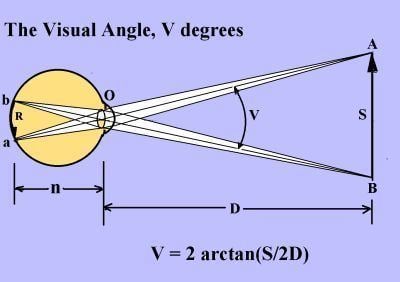 | ||
The visual angle is the angle a viewed object subtends at the eye, usually stated in degrees of arc. It also is called the object's angular size.
Contents
- Measuring and computing
- The retinal image and visual angle
- Examples
- Terminological confusions
- Representation of visual angle in visual cortex
- References
The diagram on the right shows an observer's eye looking at a frontal extent (the vertical arrow) that has a linear size
For present purposes, point
The three lines from object endpoint
The same holds for object point
The visual angle
Measuring and computing
The visual angle
Or, it can be calculated, in radians, using the formula,
However, for visual angles smaller than about 10 degrees, this simpler formula provides very close approximations:
The retinal image and visual angle
As the above sketch shows, a real image of the object is formed on the retina between points
where
Examples
If one looks at a one-centimeter object at a distance of one meter and a two-centimeter object at a distance of two meters, both subtend the same visual angle of about 0.01 rad or 0.57°. Thus they have the same retinal image size
That is just a bit larger than the retinal image size for the moon, which is about
Also, for some easy observations, if one holds one's index finger at arm's length, the width of the index fingernail subtends approximately one degree, and the width of the thumb at the first joint subtends approximately two degrees.
Therefore, if one is interested in the performance of the eye or the first processing steps in the visual cortex, it does not make sense to refer to the absolute size of a viewed object (its linear size
Terminological confusions
In astronomy the term apparent size refers to the physical angle
But in psychophysics and experimental psychology the adjective "apparent" refers to a person's subjective experience. So, "apparent size" has referred to how large an object looks, also often called its "perceived size".
Additional confusion has occurred because there are two qualitatively different "size" experiences for a viewed object. One is the perceived visual angle
The other "size" experience is the object's perceived linear size
Widespread use of the ambiguous terms "apparent size" and "perceived size" without specifying the units of measure has caused confusion.
Representation of visual angle in visual cortex
The brain's primary visual cortex (area V1 or Brodmann area 17) contains a spatially isomorphic representation of the retina (see retinotopy). Loosely speaking, it is a distorted "map" of the retina. Accordingly, the size
The observers in Murray 'et al.'s' experiment viewed a flat picture with two discs that subtended the same visual angle
